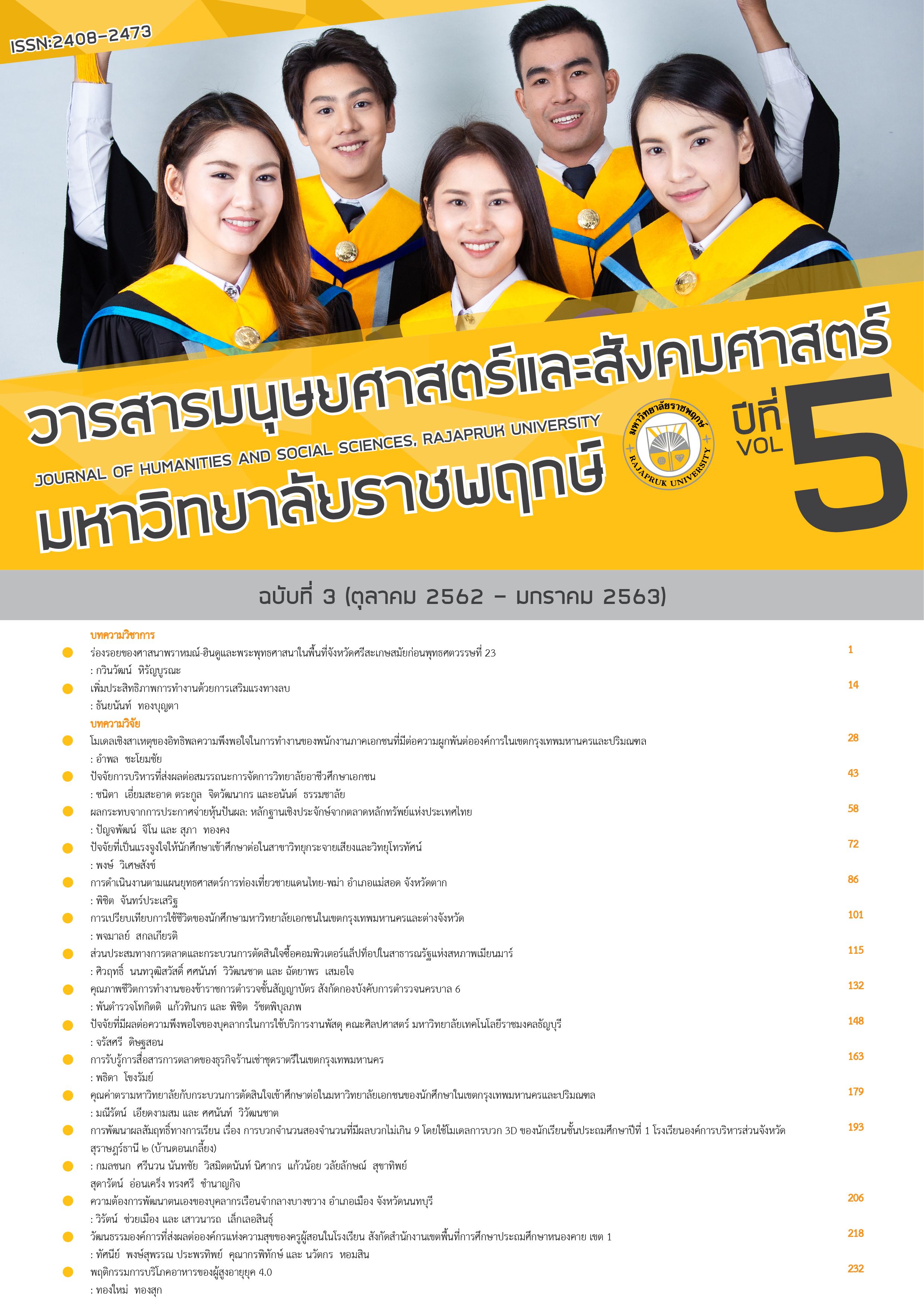The Causal Model of the Influence of Private Sector Employees’ Job Satisfaction on Organizational Commitment in Bangkok and Metropolitan Area
Main Article Content
Abstract
The objective of this study was to study the job satisfaction factor influencing the organizational commitment of private sector employees in Bangkok and metropolitan area. The research used the questionnaire to collect data from 400 respondents with purposive and simple random sampling methods. Statistical analysis used descriptive statistics, second-order confirmation factor analysis, and structural equation model analysis. The results of the research found that: 1) both variables consisted of job satisfaction and organizational commitment of employees had a high level of average; 2) Job satisfaction from the second-order confirmatory factor analysis consisted of organizational satisfaction variables in hygiene and motivation factors meanwhile the organizational commitment consisted of 3 variables: affective, continuance and normative commitments; 3) the research model was consistent with empirical data with the goodness-of-fit statistics included the Chi-square was equal to 122.509, the Chi-square/df was 1.225, GFI was 0.967, CFI was 0.991, RMR was 0.046, and RMSEA was 0.024, which can be concluded that the structural equation model is reliable to use; and 4) job satisfaction had a significant positive influence on organizational commitment.
Article Details
References
Abdullah, A. (2011). Evaluation of Allen and Meyer’s organizational commitment scale: A cross-cultural application in Pakistan. Journal of Education and Vocational Research, 1(3) June 2011: 80 - 86.
Akhigbe, O. J., Felix, O. O., and Finelady, A. M. (2014). Employee job satisfaction and organizational commitment in Nigeria manufacturing organizations. European Journal of Business and Management, 6(25): 83 - 95.
Byrne, B. M. (2010). Structural equation modeling with AMOS: Basic concepts, applications, and programming. 2nd ed. New York: Routledge.
Giritli, H., Sertyesilisik, B., and Horman, B. (2013). An investigation into job satisfaction and organizational commitment of construction personnel. Global Advanced Research Journal of Social Science, 2(1) June 2013: 1 - 11.
Hair, J. F., Black, W. C., Babin, B. J., and Anderson, R. E., (2014). Multivaliate data analysis. 7th ed. US: Pearson Education.
Islam, J. N., Mahajan, H. K., and Datta, R. (2012). A study on job satisfaction and morale of commercial banks in Bangladesh. International Journal of Economics and Research, July - August: 152 - 172.
Jaros, S. (2007). Meyer and Allen model of organizational commitment: Measurement issues. The Icfai Journal of Organizational Behavior, 6(4) March 2012: 7 - 25.
Kaplan, M., Ogut, E., Kaplan, A., and Aksay, K. (2012). The relationship between job satisfaction and organizational commitment: The case of hospital employees. World Journal of Management, 4(1) March 2012: 22 - 29.
Mahmud, M. T., Hasan, M. T., and Ashif, A. S. M. (2014). Determinants of job satisfaction: A comparative study in the banking sector of Bangladesh. International Journal of Economics and Empirical Research, 2(1) June 2014: 22 - 28.
Pitaloka, E. and Sofia, I. P. (2014). Antecedent and consequence of internal auditors job satisfaction and organization commitment. Proceeding of Kuala Lumpur International Business, Economics, and Law Conference. Kuala Lumpur: Malaysia.
Priya, N. K. and Sundaram, M. K. (2016). A study on relationship among job satisfaction, organizational commitment and turnover intention in Kolors healthcare India Pvt ltd, Chennai. International Journal of Advanced Research in Management, 7(1) January – April 2016: 58 - 71.
Rahman, M., Uddin, M. J., and Mia, M. A. S. (2012). The Role of Human Resource Management practices on Job Satisfaction and Organizational Commitment in Banking Sector of Bangladesh- A Comparative Analysis. Journal of Faculty of Business Administration, 9(1&2) July 2011 - June 2012.
Tarigan, V. and Ariani, D. W. (2015). Empirical study relations job satisfaction, organizational commitment, and turnover intention. Advances in Management & Applied Economics, 5(2) June 2015: 21 - 42.
Visessombat, T. and Chaiyakul, T. (2019). The effects of motivation, satisfaction and organization commitment to employees’ performance in automotive industry of the eastern seaboard 1 industrial estate, Rayong. Journal of Social Sciences and Humanities, Rajapruk University, 4(3) October 2018 – January 2019: 14 - 26. Retrieved on 16th January 2018, from https://www.tci-thaijo.org/index.php/rpu/article/view/169219/121741 (in Thai)
Weston, R. and Gore, P. A. (2006). A brief guide to structural equation modeling. The Counseling Psychologist, 34(5) September 2006: 719 - 751.
Yucel, I. (2012). Examining the relationship among job satisfaction, organizational commitment, and turnover intention: An empirical study. International Journal of Business and Management, 7(20) October 2012: 44 - 58.


